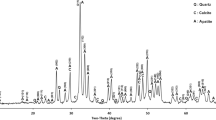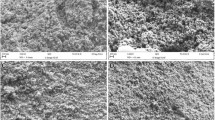Abstract
The kinetics of sintering of nanosized (20 nm) and microsized (0.7–0.9 μm) hydroxyapatite (HA) powders with continuously increasing temperature at a constant rate was studied by dilatometry. The sintering of the HA micropowders within the temperature range 1100–1300°C occurred by the mechanism of diffusion-viscous flow of crystalline particles. The kinetics of the process was described by a power-law function of time; i.e., the process rate depended on current shrinkage. The shrinkage of the nanopowders within the sintering temperature range was directly proportional to temperature, occurred by the law of viscous flow of amorphous particles, and was independent of the temperature increase rate. The apparent sintering activation energies of the studied micro- and nanopowders were 180 and 60 kJ/mol, respectively.
Similar content being viewed by others
Avoid common mistakes on your manuscript.
Among calcium phosphate materials used for bone defect replacement, ceramics based on hydroxyapatite (HA) have enhanced strength characteristics and good biological activity in implant integration into a patient’s bone tissue [1]. One of the ways to obtain such ceramics is to use nanosized powders as the initial materials. Such powders are produced mainly by chemical methods under essentially nonequilibrium unsteady-state conditions. Such production processes give particles with a loose structure and a large number of defects of various types. This is indicated by reduced values of the unit cell parameters and a noticeable decrease in the melting point [2, 3].
The number of lattice defects in surface layers of particles is known to be much larger than that in their bulk because only some of the chemical bonds of the surface atoms are compensated [4]. Moreover, the distribution of point defects over a cross section of a particle is nonuniform, and their concentration near the surface is higher [5]. Therefore, with decreasing powder particle size, the role of surface layers in interaction processes increases because their fraction in the total volume increases [6, 7]. Thus, the behavior of nanoparticles, each comprising a few unit cells, in interaction processes should differ significantly from the behavior of larger, microsized particles.
In view of considerable differences in structure between nano- and microparticles, one can expect that their sintering mechanisms are also different. In this context, the purpose of this work was to perform a comparative study of the kinetics of shrinkage of nano- and microsized HA powders on heating at a constant rate. The obtained results are original and can be used in developing a technology for producing ceramics for bone tissue reconstruction.
EXPERIMENTAL
Hydroxyapatite was obtained by mechanochemical synthesis by the reaction
The synthesis was carried out in a planetary mill: initially, the dry components were mixed, and then the process was continued in an aqueous medium. The produced suspension was aged in the mother liquor for 24 h. The precipitate was washed, filtered off, and dried at 80–100°C. The powder (hereinafter referred to as the nano-HA) was rubbed through a sieve with a mesh size of 0.1 mm. A part of the powder (henceforth referred to as the micro-HA) was calcined at 1100°C in a muffle furnace at a heating rate of 10 K/min without holding.
The phase composition of the obtained powders was determined by X-ray powder diffraction analysis with a Shimadzu XRD-6000 diffractometer (Japan). The specific surface area Ssp was found by the low-temperature nitrogen adsorption method with a Micromeritics TriStar 3000 system. Microscopic studies of the micropowders were made by scanning electron microscopy with a Tescan Vega II SBU scanning electron microscope; microscopic studies of the nanopowders were made by transmission electron microscopy with an EMV-100 BR (USSR).
The sintering of the materials was investigated by measuring the continuous shrinkage with a NETZSCH DIL 402C horizontal dilatometer with a corundum sample holder and a high-resolution displacement transducer (500–5000 μm, accuracy to 1 × 10–5) in an argon atmosphere. The samples were compacted at a pressure of 5 MPa as cylinders 5 mm in diameter and about 4 mm in height with a density of 1.8 ± 0.1 g/cm3. The linear sizes of the samples were measured with continuously increasing temperature to 1400°C at a constant rate of 5, 10, or 20 K/min. The apparent activation energy of sintering was calculated using a procedure for describing nonisothermal experiments [6, 8].
The synthesized nano-HA consisted of elongated particles, each 10–30 nm across and to 50–60 nm in length, surrounded by an amorphous shell. The particles were formed by blocks of nanocrystals about 5 nm in size (Fig. 1a).
The micro-HA powder comprised round particles with an average size to 0.8 μm (Fig. 1b). The X-ray powder diffraction analysis detected the presence of single-phase HA. The degree of crystallinity of the micropowder is higher than that of the nanopowder, which was confirmed by calculating the coherent scattering domain sizes by the Scherrer method. The specific surface areas of the nano-HA and the micro-HA were 98.5 and 2.5 m2/g (at average surface diameters of 20 and 760 nm), respectively.
Figure 2 presents the results of determining the continuous shrinkage of the nano-HA and the micro-HA. The dilatometric data in Fig. 2 show an increase in the shrinkage of the nanopowder, which is initially small on heating to approximately 600°C and then significant up to 1200°C. With a further increase in temperature, the curve plateaus. Characteristically, the nanopowder shrinkage is independent of heating rate (at a fourfold increase in the rate); i.e., the course of the process is time-independent (d(Δl/l0)/dτ = const) but temperature-dependent.
Heating of the micropowder causes a small shrinkage, then ordinary thermal expansion (to a temperature of about 1100°C), and then shrinkage again. The course of the shrinkage at the last stage depends on heating rate, as it is typically observed in sintering of microsized powders. The shrinkage kinetics in this case is known to be described by the law (Δl/l0)n = Kτ, by which the process rate depends on the previous state of the sample, i.e., on the current Δl/l0 value.
The pronounced difference in behavior between the two considered powders is particularly well seen in the plot of logarithm ln(Δl/l0) of shrinkage versus inverse temperature 1/T of process (Fig. 3). For the nano-HA almost throughout the sintering temperature range (600–1200°C), this plot is linear; i.e., ln(Δl/l0) = a + b/T or Δl/l0 = Aexp(–Q/RT), where R is the universal gas constant and Q is the activation energy. Coalescence of particles in this case is most likely to occur by rearrangement of bonds of surface atoms, by which the centers of particles approach each other and pores open to the surface along wide loose boundaries.
Data of Fig. 2 in ln(Δl/l0)–1/T coordinates for (a) nano-HA and (b) micro-HA powders at a heating rate of (1) 5, (2) 10, and (3) 20 K/min.
Thus, the kinetics of sintering of ceramics based on HA depends on particle size. The calculation of the apparent activation energies of sintering of the nano- and micropowders demonstrated a significant difference between them: 60 kJ/mol as against 180 kJ/mol, respectively. The obtained data suggest that the sintering mechanisms of such powders are different. For the micro-HA, the course of the sintering is determined by the dependence of the structure of the material at each moment of time on the previous state of the sample, whereas for the nano-HA, this is not the case. The sintering of the micropowders occurs by classical mechanisms of densification of crystalline solids by diffusion of vacancies from concave parts of the surfaces of contacting particles to convex ones, provided that the point of contact is fixed. On the other hand, the mechanism of sintering of the nanopowders is close to viscous flow, by which there simultaneously are an increase in the area of contacts and an approach of the centers of particles by their coalescence, with the coalescence rate being determined by the viscosity of the substance. The obtained results can be used for producing bioceramics for bone surgery.
REFERENCES
Barinov, S. M. and Komlev, V.S., Biokeramika na osnove fosfatov kal’tsiya (Calcium Phosphate-Based Bioceramics), Moscow: Nauka, 2014.
Gleiter, H., Acta Mater., 2000, vol. 48, no. 1, pp. 1–29.
Chernyshev, A.P., Doctoral Dissertation in Mathematics and Physics, Novosibirsk, 2014.
Petrunin, V.F., Yadern. Fiz. Inzh., 2011, vol. 2, no. 3, pp. 196–204.
Chebotin V.N., Fizicheskaya khimiya tverdogo tela (Physical Chemistry of Solids), Moscow, 1982.
Bakunov, V.S., Belyakov, A.A., Lukin, E.S., and Shayakhmetov, U.Sh., Oksidnaya keramika: spekanie i polzuchest’ (Oxide Ceramics: Sintering and Creep), Moscow: Izd. RKhTU im. D.I. Mendeleeva, 2007.
Geguzin, Ya.E., Fizika spekaniya (Physics of Sintering), Moscow: Nauka, 1985.
Woolfrey, J.L. and Bannister, M.J., J. Am. Ceram. Soc., 1972, vol. 55, no. 8, pp. 383–387.
ACKNOWLEDGMENTS
This work was performed within the framework of State Assignment no. 007–00129–18–00.
Author information
Authors and Affiliations
Corresponding author
Additional information
Translated by V. Glyanchenko
Rights and permissions
About this article
Cite this article
Petrakova, N.V., Bakunov, V.S., Barinov, S.M. et al. Features of the Kinetics of Sintering of Hydroxyapatite Powders with Various Particle Sizes. Dokl Chem 483, 308–311 (2018). https://doi.org/10.1134/S0012500818120029
Received:
Published:
Issue Date:
DOI: https://doi.org/10.1134/S0012500818120029







